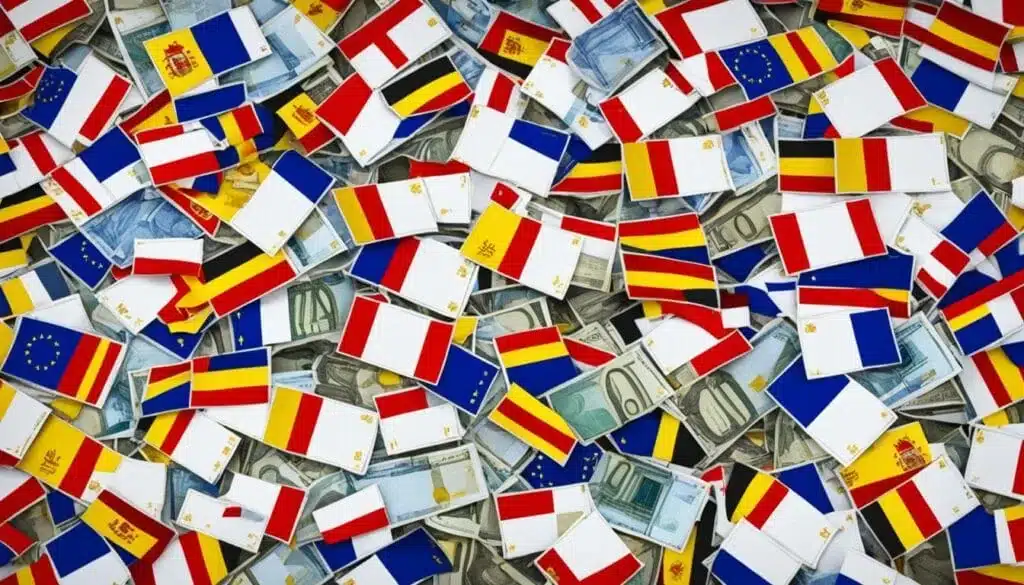What Is Spain’s Currency, a richly diverse country located in southwestern Europe, has its own national currency. The official currency of Spain is the euro, which is also used by 18 other European Union member countries. But what exactly is the significance of Spain’s currency, and why does it matter globally?
The euro became Spain’s national currency in 2002, replacing the peseta. As one of the largest economies in Europe, Spain’s use of the euro has a significant impact on both regional and global economies. The euro is the second most traded currency in the world’s foreign exchange markets, making it crucial for international trade and investment.
Spain’s adoption of the euro also facilitates travel within the Eurozone, as it eliminates the need for currency exchange when visiting other euro-using countries. This convenience makes it easier for tourists and business travelers to navigate financial transactions across borders.
Understanding Spain’s currency is essential for anyone traveling to the country or engaging in business transactions with Spanish entities. It affects everything from the cost of goods and services to the exchange rates between different currencies.
Key Takeaways:
- Spain’s official currency is the euro.
- The euro is the second most traded currency globally.
- Spain’s adoption of the euro facilitates travel and trade within the Eurozone.
- Understanding Spain’s currency is crucial for travelers and businesses.
- The euro has a significant impact on the global economy.
The Euro: Spain’s Monetary Unit
The euro is the official currency of Spain and plays a significant role in the country’s economy. It is also the currency used by 18 other European countries, collectively known as the eurozone. The symbol for the euro is €.
The euro is available in both coins and banknotes. There are eight different euro coins, ranging in value from one cent to two euros. The designs on the coins vary by country, and Spain’s euro coins feature three distinct designs: the cathedral of Santiago de Compostela, Spanish author Miguel de Cervantes, and King Felipe VI.
On the other hand, there are seven different euro banknotes, with denominations ranging from five euros to 500 euros. The banknotes are all the same regardless of the country and feature architectural styles from various periods in European history.
Euro Coins:
| Denomination | Design |
|---|---|
| 1 cent | Cathedral of Santiago de Compostela |
| 2 cents | Cathedral of Santiago de Compostela |
| 5 cents | Spanish author Miguel de Cervantes |
| 10 cents | Spanish author Miguel de Cervantes |
| 20 cents | King Felipe VI |
| 50 cents | King Felipe VI |
| 1 euro | King Felipe VI |
| 2 euros | King Felipe VI |
All euro coins and banknotes are valid across the eurozone, meaning they can be used for transactions in any country that has adopted the euro as its currency. This makes it convenient for travelers who can use the same currency throughout their journey across multiple countries in the eurozone.
Using Bank Cards in Spain

When traveling to Spain, it’s important to understand how to effectively use your bank cards to manage your finances. Bank cards, including debit cards, credit cards, and prepaid travel cards, are widely accepted throughout the country, making transactions convenient and hassle-free.
Debit Cards:
Debit cards are commonly accepted in stores, restaurants, and ATMs across Spain. Using your debit card allows you to withdraw cash, make purchases, and access funds easily. However, it’s essential to be aware of any fees associated with ATM withdrawals and transactions abroad. Some banks may charge high fees for these services, which can impact the overall cost of your trip.
Credit Cards:
Credit cards offer added security and convenience, especially in case of emergencies. They can be used for various purchases and services while traveling in Spain. However, it’s crucial to note that credit cards may come with additional charges, such as cash advance fees, international transaction fees, and ATM withdrawal charges. Before using your credit card, it’s best to check with your bank or credit card provider to understand the specific fees and terms associated with using your card in Spain.
Prepaid Travel Cards:
A prepaid travel card is an alternative option for managing your expenses while in Spain. These cards can be loaded with euros before your trip, providing a fixed spending limit and helping you stick to your budget. However, it’s important to be aware of potential fees associated with prepaid travel cards, such as reload fees and ATM withdrawal fees. Compare different card options and read the terms and conditions to find the one that suits your needs and offers the best value for your money.
Remember to inform your bank or credit card provider of your travel plans to avoid any potential issues or card blocks. Additionally, it’s always a good idea to have multiple payment methods available, such as a combination of bank cards and some cash, to ensure you can make payments wherever you go.
Overall, using bank cards in Spain provides a convenient and secure way to manage your finances. However, it’s essential to be mindful of potential fees, especially when it comes to ATM withdrawals and currency conversion. By understanding the terms and conditions associated with your bank cards and choosing the right option for your needs, you can make the most of your financial transactions while exploring all that Spain has to offer.
Currency Exchange in Spain
When traveling to Spain, it’s important to be familiar with the different options for currency exchange. Whether you need euros during your trip or want to exchange any remaining currency back to your local currency, there are several convenient methods available.
Spanish Bank ATMs
One of the easiest ways to obtain euros in Spain is by using Spanish bank ATMs, known as cajeros automáticos. These ATMs are widely available throughout the country, making it convenient for travelers to withdraw cash in euros as needed. Most Spanish bank ATMs accept major debit and credit cards from international networks, providing a hassle-free way to access currency. Just look for ATMs with the logos of international card networks like Visa or Mastercard.
Currency Exchange Outlets
If you prefer to exchange currency in person, you can find currency exchange outlets in touristy areas of Spain. These outlets are usually marked with the sign ‘cambio’ and offer currency exchange services for various currencies, including euros. However, it’s important to note that these outlets may have higher commissions and less favorable exchange rates compared to other options.
Buying Currency Before Your Trip
Another option for acquiring euros is to buy currency before your trip. This can be done through online currency exchange platforms or local currency exchange stores in your home country. Buying currency in advance allows you to lock in exchange rates and potentially get a better value for your money. Additionally, having euros on hand before you arrive in Spain can provide peace of mind and eliminate the need to search for a currency exchange outlet immediately upon arrival.
Traveller’s Cheques What Is Spain’s Currency
In the past, traveler’s cheques were a popular method of carrying and exchanging currency while traveling. However, they have become less common in recent years due to advancements in electronic payment methods and the widespread acceptance of debit and credit cards. While some establishments in Spain may still accept traveler’s cheques, they can be more hassle than they’re worth. It’s generally recommended to use other methods for currency exchange during your trip.
In summary, currency exchange in Spain can be done easily through Spanish bank ATMs, currency exchange outlets, or buying currency before your trip. Each method has its advantages and considerations, so choose the option that best suits your needs and preferences. It’s always a good idea to have some euros on hand for immediate expenses, but it’s also important to be mindful of fees and exchange rates to ensure you get the best value for your money.
Familiarizing Yourself with Spanish Euro
When traveling to Spain, it’s essential to familiarize yourself with the euro denominations, euro coins design, and euro banknotes design. Understanding the different values of the euro and recognizing the unique features of Spanish euro coins and banknotes can enhance your overall experience in the country.
The euro is divided into 100 cents and is available in the following denominations:
- One cent
- Two cents
- Five cents
- Ten cents
- 20 cents
- 50 cents
- One euro
- Two euros
Each country within the eurozone has the freedom to choose their own design for the national side of the coins. However, the other side of the coins depicts a map of the European Union, symbolizing the unity and cooperation among member countries. In the case of Spanish euro coins, they feature unique designs representing significant cultural icons:
- The cathedral of Santiago de Compostela
- Spanish author Miguel de Cervantes
- King Felipe VI
Euro banknotes also showcase distinct designs, each representing a specific era of European architecture. The use of different colors and artistic elements provides a visually appealing and culturally rich representation of the euro banknotes.
Euro Banknotes Design:
| Denomination | Color | Design |
|---|---|---|
| €5 | Gray | “Classical” architecture |
| €10 | Red | “Romanesque” architecture |
| €20 | Blue | “Gothic” architecture |
| €50 | Orange | “Renaissance” architecture |
| €100 | Green | “Baroque and Rococo” architecture |
| €200 | Yellow | “19th-century architecture” |
| €500 | Purple | “Modern architecture” |
By familiarizing yourself with the euro denominations and the unique design elements of Spanish euro coins and banknotes, you’ll have a better understanding and appreciation of the currency used in Spain.
Average Costs in Spain
When planning a trip to Spain, it’s important to consider the average costs of various expenses to help you budget effectively. Prices can vary depending on the region and the type of establishment you choose. Here’s an overview of the average costs in Spain:
Hotel Costs
A comfortable mid-range hotel room in Spain can cost between 60 and 150 euros per night. Prices may vary depending on the location and the time of year you visit.
Daily Set Menu
If you’re looking for a budget-friendly meal option, consider trying the daily set menu offered at many restaurants in Spain. On average, these menus cost around 10 euros per person and typically include a starter, main course, dessert, and sometimes a beverage. It’s a great way to enjoy traditional Spanish cuisine without breaking the bank.
Transportation Costs
Getting around in Spain is relatively affordable, especially when using public transportation. A single public transport ticket, such as a metro or bus ticket, typically costs around 1.50-2 euros. If you enjoy exploring the city on foot, many popular attractions are within walking distance. If you prefer to rent a car, prices can range from 25 euros per day, depending on the type of car and rental duration.
Additional Expenses
While these are the average costs for hotels, meals, and transportation, it’s important to budget for other expenses you may incur during your trip. For example, a beer at a bar or restaurant may cost around 2 euros, and prices for other beverages may vary. Keep in mind that prices can also differ depending on the city or tourist destination you’re visiting.
To help you visualize the average costs in Spain, here’s a comprehensive table summarizing the information:
| Expense | Average Cost |
|---|---|
| Mid-Range Hotel Room (per night) | 60-150 euros |
| Daily Set Menu (per person) | Around 10 euros |
| Beer (at a bar) | Around 2 euros |
| Public Transport Ticket | 1.50-2 euros |
| Car Rental (per day) | From 25 euros |
These average costs serve as a general guideline, but it’s important to remember that prices can vary based on factors such as location, season, and personal preferences. It’s always a good idea to research specific costs for the areas you plan to visit and adjust your budget accordingly.
Now that you have a better understanding of the average costs in Spain, you can start planning your trip and budget accordingly. By being aware of these expenses, you’ll be better prepared for an enjoyable and affordable experience in this beautiful country.
Tips to Save Money in Spain
Traveling to Spain can be an exciting and memorable experience. To make the most of your trip and save money along the way, consider these travel money tips:
- Avoid Airport Currency Exchange:
When arriving in Spain, it’s best to avoid currency exchange at airports. They often offer poor exchange rates and high fees. Instead, wait until you reach your destination to exchange your money at a local bank or currency exchange.
- Don’t Carry Too Much Cash:
Cash is essential while traveling, but carrying too much can be risky. Only carry the amount of cash you need for daily expenses and keep the rest in a safe place, like your hotel’s safe. This way, you minimize the chances of losing a large sum of money.
- Pay in the Local Currency:
When making payments in Spain, always opt to pay in the local currency (euros). Some merchants and service providers may offer dynamic currency conversion, which may seem convenient, but often comes with unfavorable exchange rates and additional fees.
- Have Different Payment Methods:
Having different payment methods, such as prepaid travel cards, debit cards, and credit cards, can provide added convenience and security. If one card is lost or stolen, you’ll have alternative options to rely on. Just be sure to inform your bank or card issuer about your travel plans to avoid any unexpected issues.
- Avoid Cash Advances with Credit Cards:
While credit cards can be convenient, it’s important to avoid cash advances. Cash advances often come with high fees and immediate interest charges, making them an expensive option for obtaining cash. Stick to using credit cards for regular purchases and use ATMs or currency exchange offices for cash withdrawals.
By following these travel money tips, you can save money and have a worry-free trip in Spain.
What to Do with Leftover Euros

If you have leftover euros at the end of your trip, there are several options for disposing of them. Here are some suggestions:
- Donate to Charities: Some airlines offer currency collection envelopes that allow travelers to donate their leftover euros to charities. Additionally, Australian airports have collection boxes specifically designed for unwanted currency, which is then donated to charities. This way, you can give back while getting rid of your excess euros.
- Currency Exchange: If you prefer to exchange your leftover euros for your local currency, you can do so at an airport or a currency exchange in the city. This allows you to convert your euros back into usable funds once you return home.
- Hold onto Euros for Future Use: Another option is to hold onto your euros for future trips to Europe. The euro is the official legal currency of 19 eurozone countries and is accepted in many more. By keeping your euros, you’ll be prepared for your next European adventure without the hassle of exchanging currency.
No matter what option you choose, it’s important to find a solution that suits your needs and preferences. By making the most of your leftover euros, you can ensure that they are put to good use.
| Options | Benefits |
|---|---|
| Donate to Charities | – Support a good cause |
| Currency Exchange | – Convert euros back into local currency |
| Hold onto Euros for Future Use | – Be prepared for future trips to Europe |
Also Read : Choosing Finance As Your Major: How To Succeed And Grow
Conclusion
Understanding the currency of Spain is crucial for travelers, as it has implications beyond just travel. The euro, as Spain’s official currency, plays a significant role in the global economy as the second most traded currency. Therefore, it’s important for travelers to be aware of the various options for using bank cards, exchanging currency, and managing their travel expenses in Spain.
By following money-saving tips and being mindful of fees and exchange rates, travelers can make the most out of their experience in Spain. It is advisable to avoid currency exchange at airports, as they often offer poor rates. Instead, carrying only the necessary amount of cash and utilizing prepaid travel cards or debit/credit cards can be more convenient and cost-effective.
Paying in the local currency and having different payment methods available are beneficial to avoid high fees and unfavorable exchange rates. Lastly, it’s advisable to be cautious with cash advances on credit cards due to the associated fees and immediate interest. By adhering to these guidelines, travelers can optimize their financial decision-making and fully enjoy their time in Spain.
FAQs
Q: What is the official currency of Spain?
A: The official currency of Spain is the Euro (EUR). It is issued by the European Central Bank and is the main currency used in Spain.
Q: Will I be able to use my debit card in Spain?
A: Yes, you can use your debit card in Spain. However, it’s important to check with your bank regarding foreign transaction fees and to inform them of your travel plans to avoid any issues with using your card abroad.
Q: Should I bring cash for smaller expenses while traveling in Spain?
A: It’s advisable to carry some cash for smaller expenses while traveling in Spain. Many shops and restaurants accept cash, and having some local currency can be helpful, especially in areas where card payments may not be widely accepted.
Q: What is the best way to exchange foreign currency for my trip to Spain?
A: You can exchange foreign currency for Euros at currency exchange offices, banks, or ATMs in Spain. It’s important to be mindful of the exchange rates and any associated fees when converting your money. Another convenient option is to use a currency converter to get the most updated rates.
Q: Are there any recommended travel money tips for a trip to Spain?
A: Some travel money tips for a trip to Spain include familiarizing yourself with the Euro symbol (€), being aware of any potential hidden fees when using your cards, and considering using a prepaid travel money card to manage your expenses while abroad.
Q: How helpful is a Wise card for managing travel money in Spain?
A: A Wise card can be very helpful for managing travel money in Spain. It allows you to load money onto the card, see the exchange rate in real time, and avoid hidden fees typically associated with traditional banks.
Q: What are the options for obtaining local currency upon arrival in Spain?
A: Upon arrival in Spain, you can obtain local currency from ATMs, currency exchange offices, or some banks. It’s important to check for any additional fees or charges that may apply when using these services.
Q: What currency-related issues should I be aware of when visiting Spain?
A: When visiting Spain, you should be aware of potential issues such as fluctuating exchange rates, the possibility of hidden fees when using your cards, and the varying acceptance of cards and cash at different establishments. It’s helpful to plan ahead and have a good understanding of your travel money options.
Q: Can I use a currency converter to check the exchange rate before my trip to Spain?
A: Yes, you can use a currency converter to check the current exchange rate for the Euro before your trip to Spain. This can help you plan your travel budget and make informed decisions when exchanging or managing your currency.
Q: Are there any specific travel money considerations for Australian visitors converting AUD to EUR for their trip to Spain?
A: Australian visitors converting AUD to EUR for their trip to Spain should consider the exchange rate, potential fees for currency conversion, and the best options for obtaining Euros in advance or upon arrival in Spain.





